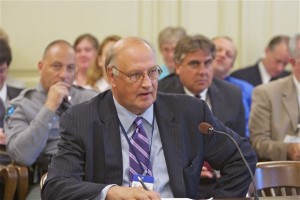Chemical Industry Used DEP Cleanup Delays to Privatize Program
Now They Can’t Even Meet The First 5 Year Deadline To Sample Sites
Chemical Industry Says They’re Too Busy “Chasing Every Molecule”
Privatization Is Not Enough – Polluters Want A Complete “Paradigm Shift”
DEP Still Flying Blind – Mandated Risk Priority System Still Not In Place
LSRP’s Not Subject to OPRA – Communities in the Dark
“A bald faced strategem of diversion – let’s get past the slogans” ~~~ Bill Wolfe, NJ PEER
“I take issue with the revisionist history of Mr. Wolfe” ~~~ Mike Engenton, NJ Chamber of Commerce
It is hard to overstate the hypocrisy and chutzpa of this lame duck legislative maneuver, even by NJ standards. Follow me:
A controversial bill with significant implications is moving under the media radar and quickly through the lame duck legislative session.
The bill, sponsored by Environment Committee Chairman Smith, is greased: out of seemingly nowhere, it was quietly introduced on November 18, heard for discussion last Thursday (Dec. 5), and – despite receiving harsh opposition (from yours truly, listen here) – is posted on the agenda and likely to be released from the Environment Committee a week later, on December 12 (under cover of media focus on the clean car and RGGI bills cynically posted to provide diversion).
 [Update: 12/11/13 – exactly as predicted, NJ Spotlight takes the bait and reports on the political stunt diversion while big corporate polluter bill stays under the radar: DEMOCRATIC LAWMAKERS WANT NJ BACK IN REGIONAL CLEAN-AIR INITIATIVES.
[Update: 12/11/13 – exactly as predicted, NJ Spotlight takes the bait and reports on the political stunt diversion while big corporate polluter bill stays under the radar: DEMOCRATIC LAWMAKERS WANT NJ BACK IN REGIONAL CLEAN-AIR INITIATIVES.
It is simply amazing that this cynical game is played so consistently yet media – like Charlie Brown – always takes the bait. – end update].
There is an identical Assembly version, sponsored by the Assembly Env. Cmte Chair, so it looks like this is the typical stealth – ram it through in lame duck – kind of thing.
The bill (S3075) would extend a key cleanup mandatory deadline set by the Legislature under the 2009 “Site Remediation Reform Act”(SRRA), the controversial legislation that privatized the cleanup of toxic waste sites in NJ.
During the run-up to and legislative debate on the SRRA, corporate polluters mounted a massive PR campaign and lobbying effort to blame DEP for delays and backlogs in cleaning up thousands of toxic sites – delays caused largely by the private sector’s refusal to spend the billions of dollars required to cleanup sites.
Like the little boy who murders his parents and then pleads for mercy as an orphan, the polluters used the delays as evidence to claim that DEP bureaucracy is the source of the delay and convinced DEP Commissioner Lisa Jackson to say “the DEP cleanup process is broken” – the huge backlogs thus became the primary rationale to privatize the cleanup program.
Privatization – we were told repeatedly – would lead to quicker, better, and cheaper cleanups.
Once DEP bureaucrats and red tape were eliminated, cleanups would be driven by market incentives and proceed like greased lighting!
To hold polluters accountable to those promises of faster cleanup, the law gave polluters 5 years to complete a document known as a “remedial investigation” (RI). An RI is basically a study that samples and characterizes pollution of soil and groundwater at a toxic site.
Under the law, if a polluter failed to meet the 5 year deadline for completion of the RI, then DEP would assume direct oversight of the cleanup of the site: No more private LSPRP in charge.
An RI is just the FIRST STEP in the cleanup process – it is not the cleanup of the site – so the 5 year deadline was more than adequate time to do the work, especially considering the fact that mandatory cleanup deadlines were discussed and some imposed by DEP years BEFORE the passage of the 2009 law, so the polluters had plenty of advanced warning that deadlines were coming.
The generosity of the 5 year 2014 deadline also is illustrated by historical context – the NJ toxic site cleanup program is mature and DEP and the polluters have been working on most of these sites for up to 37 years, since the 1976 passage of the Spill Compensation and Control Act, NJ’s state version and model for the better known federal Superfund law.
The 5 year RI deadline is the only mandatory deadline in the law. There are other deadlines, but the DEP has discretion to extend several other regulatory deadlines and has consistently failed to enforce those deadlines, e.g. polluters had 3 years, or until 2012, to hire a Licensed Site Remediation Professional (LSRP).
Yet, according to the testimony of the chemical industry – there are 700 – 900 toxic sites where LSRP’s have not yet been hired, a major unenforced violation of DEP regulations. Other testimony by Mike Pisauro, an LSRP Board member, estimated are that there are many more than that, perhaps as many as 2,000 sites in violation of law that DEP has failed to take enforcement action.
If the DEP has not enforced something as simple and basic as a 2 year old deadline for hiring an LSRP, how can the legislature and the public trust them to enforce something complex, like a 2 year extension for “good actors” with legitimate delays in completing the RI due to technical problems beyond their control? (two illustrations were offered: inability to secure access to property for of site sampling and co-mingled plumes of groundwater contamination from multiple sources – as if these were novel issues. The criteria in the draft bill are not limited to those to examples.)
While DEP has failed to enforce their own regulations, I’m told that they sent out a bunch of scary letters threatening to enforce the mandatory the RI May 2014 deadline – “please don’t blame us, we have no discretion, our hands are tied by the legislature” – almost as if they wanted to trigger exactly the backlash by polluters that led to this relief bill.
Additionally, again according to the testimony of the chemical industry, as I’ve previously warned, DEP has failed to meet a May 7, 2010 deadline set by the Legislature to adopt a “Remedial Priority System” (RPS) to set science and risk based priorities to guide the cleanup program and inform the public about the “worst” or highest risks sites in their communities.
At the hearing, DEP was nowhere to be found. It is simply amazing that the Legislature is provided a briefing on the status of implementing a major environmental law by Hal Bozarth of the chemical industry, and not the DEP.
There appears to be some warped idea that privatization of the toxic site cleanup program has cut DEP completely out of the picture, while the chemical industry is put in charge.
Senator Smith was a prime sponsor of the SRRA, so of course he would prefer to keep discussion of flaws and failures in implementing the law under the radar, especially when his attempt to “fix” those flaws ignores glaring problems and benefits only a handful of major corporate polluters for dragging their feet in and failing to meet cleanup deadlines. For some reason, Smith and cosponsor Senator Bateman both missed the hearing.
We opposed the SRRA and predicted it would be a disaster – and it is turning out to be a slow motion train wreck.
To understand the nature of that disaster, we urge readers to take the time to listen to the remarkably arrogant and disingenuous testimony of the NJ Chemistry Council and the NJ Chamber of Commerce.
Instead of taking responsibility for failure to meet the 5 year deadline they promised they would achieve, and humbly asking for a small bore 2 year extension under narrow circumstances that were publicly justified, the polluters went large and on offense.
The Senate bill provides for a 2 year extension, under certain circumstances. DEP would conduct an expedited review and provide a public notice, much like a permit process.
But the polluters rejected that approach – they want even more!
They asked for a broader, automatic 5 year extension that would be self implementing (i.e. no DEP review, no public transparency – just a private certification).
Hal Bozarth of the Chemistry Council even used blatantly false examples to justify the need for the bill.
Bozarth claimed that complex RCRA and Superfund sites caused delays in completing the RI. But the SRRA carves out federal RCRA and Superfund sites and EPA does not allow NJ’s LSRP program at those sites because NJ’s SRRA law does not meet minimum federal requirements. And complex high risk sites are supped to be under DEP oversight, not LSRP cases.
Going even further beyond the scope of Smith’s relief bill, amazingly, the LSRP representative asked for amendments that amounted to permission to withhold information and coverup the existence of toxic contamination. Specifically, the professional standards of current require disclosure and reporting of the discovery of “immediate environmental concern” conditions and the discharge of toxic pollutants at a site. The LSRP explained that that mandatory disclosure and reporting requirements hurt them in getting work from clients to do what are called “due diligence reviews” before purchasing property.
If those reporting and disclosure requirements were eliminated, and LSRP’s could keep that information confidential, then they could get more business! Yippie! Lets us be allowed to hide the known presence of toxic contamination!
Bozarth, from the chemical industry even had the balls to ask for major relief from liability, financial assurance requirements to allow self guarantees, and to be subject to even weaker cleanup standards!! (i.e. the industry designed Risk Based Corrective Action, what Bozarth called a “paradigm shift”).
Like I said, this was outrageous, even for NJ lame duck standards.
We’ll keep you posted – the bill is up again on Thursday.


Pingback: maillot de foot espagne xavi
Pingback: maillot turbo mexico
Pingback: que tipo de letra tienen las camisetas del real madrid
Pingback: tottenham kit 13 14
Pingback: camiseta seleccion argentina 1986 maradona 10 original lecoq
Pingback: camisa do brasil da lacoste
Pingback: liverpool fc jersey toddler
Pingback: camiseta portugal negra
Pingback: camisetas futbol online chile
Pingback: spanien trikot 2012 damen
Pingback: venta camisetas de futbol originales argentina
Pingback: Men's Nike San Francisco 49ers 53 NaVorro Bowman Elite Grey Shadow NFL Jersey
Pingback: camiseta oficial del manchester united 2013
Pingback: camiseta de liverpool 2014
Pingback: clay matthews girl jerseys
Pingback: ajax shirts history
Pingback: camisa belgica centauro
Pingback: Women's Nike San Francisco 49ers 52 Patrick Willis Game Red Breast Cancer Awareness Super Bowl XLVII NFL Jersey
Pingback: camiseta oficial de chile mundial 2014
Pingback: WolfeNotes.com » The Posturing and Hypocrisy On The Exxon Deal Is Stunning
Pingback: WolfeNotes.com » Murphy DEP Proposes Huge New Loopholes In Toxic Site Cleanup Standards
Pingback: WolfeNotes.com » NJ DEP Commissioner Misleads The Public About The DEP Role In Hackensack River Superfund Designation